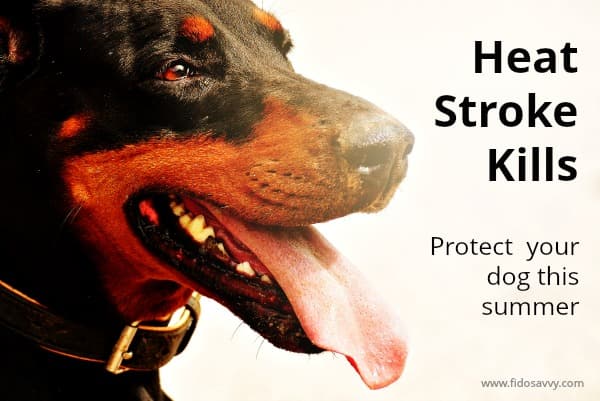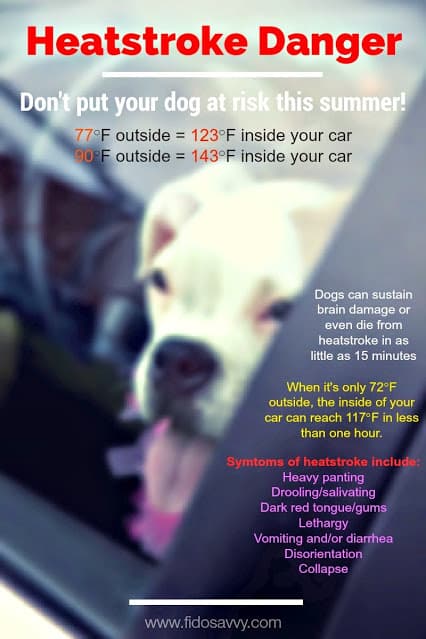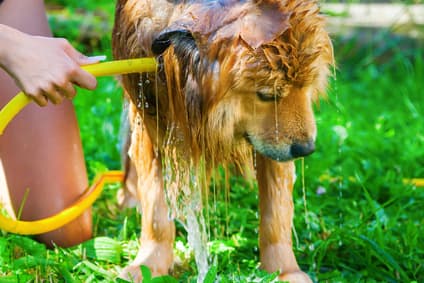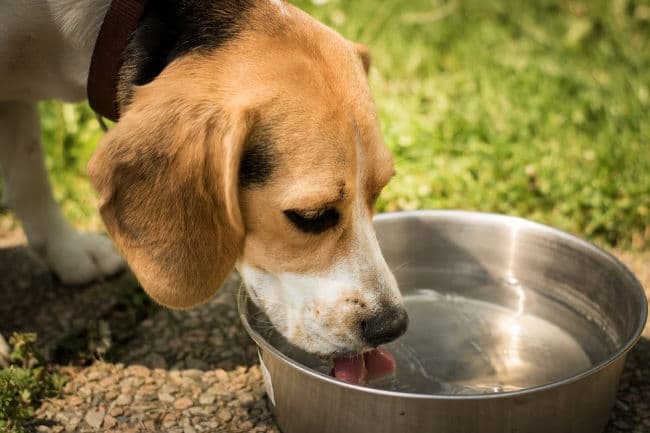FYI: If you buy something through a link on this site I may earn a commission - at NO extra cost to you.
Dog Heat Stroke Guide
Dog heat stroke happens when your dog gets too hot and his body isn't able to cool itself effectively.
Heat stroke in dogs is also sometimes referred to as heat exhaustion, and the correct medical name for it is hyperthermia.
Even though it's caused by your dog being too hot, heat stroke is not the same as a fever and is not caused by illness, but by external temperatures.
A dog's normal body temperature is around 101F.
When your dog's core body temperature is forced to rise above that and reaches 104F, heat stroke begins to occur. A core temperature of 106F or higher in dogs is likely to be fatal. (jump to tips on how to take your dog's temperature).
Dogs can't sweat the way we do and their body's cooling systems are not very efficient. The only way for them to cool down is by panting, or by evaporation from the only sweat glands they have... which are on the bottom of their paws.
- Symptoms of heat stroke in dogs
- Dog heat stroke treatment
- About recovery
- Heat stroke prevention for dogs

The most common cause of heat stroke in dogs are:
- Being outdoors too long without adequate shade or water
- Being left in a car during hot weather
* Even if he has access to shade and water, it's still perfectly possible for a dog to get heat stroke if he is outdoors for an extended period when it's hot.

Dog Heat Stroke Symptoms
There are a lot of symptoms that occur when a dog is suffering from heat stroke. Some of them are easy to see, some are not.
If you're in any doubt about whether or not your dog is in heat-related trouble, take his/her temperature right away.
Time is an absolutely crucial element in heat stroke recovery and can mean the difference between life or death for dogs with heat exhaustion.
Most common signs of heat stroke in dogs:
- Excessive panting
- Excessive drooling
- Red gums/tongue/lips (or possibly pale gums)
- Increased heart rate
- Fast breathing
- Shivering
- Lethargy
- Vomiting
- Diarrhea
- Reduced urination
- Difficulty breathing
- Loss of balance/co-ordination
- Seizures
- Collapse
- Coma
Once heat-stroke has become severe there are major reactions in your dog's body including internal bleeding, heart arrhythmia, clinical shock, organ failure and heart failure.
These are very likely to lead to death.
Dog Heat Stroke Treatment
Heat stroke in dogs can often be treated successfully if it's recognized early enough and treated promptly.
A dog with heat stroke NEEDS to be seen by a veterinarian on an urgent/emergency basis.
But if his temperature is above 104 it's important to start cooling him down first.
The stress of a car ride added to the heat-damage that is being done to his body could be too much for him and make matters worse.
I strongly recommend calling your veterinarian as soon as you realize your dog is in trouble and ask for advice.
If your regular vet is closed, call a local 24 hour pet clinic/hospital. It's that important.
A vetarinarian will be able to evaluate over the phone and if you can take your dog's temperature that will give him/her valuable information.
If your dog is suffering from heat stroke/heat exhaustion but is walking, drinking, urinating normally and seems to be minimally affected you could just douse him with cool water a couple of times and get in the car with the A/C running to head straight to the vet.
It's a case-by-case situation with no one-size-fits-all answer.
Use your common sense, get veterinary advice and take it from there.
The key is realizing what is happening before your dog's core body temperature gets too high and starts to cause serious, life-threatening complications.
If his temp is between 104 and 106 faranheit taking the right measures quickly will most likely save the day.
Anything above 106F can cause irreversible damage to multiple bodily systems and lead to death, but that doesn't mean that there's no hope.
Here's how to treat dog heat stroke by cooling Fido down the RIGHT way:
1. Get him out of the heat
The very first thing to do is to move your dog from the sun into a shady spot, preferably where there is a breeze or at least free-flowing air.
The shade given by trees is several degrees cooler than the shade given by buildings so if there are trees so much the better.
If you can get him indoors into the A/C and into a bathtub or shower that's great but don't stress him out if it's too much for him or he's not familiar with doing that.
2. Take his temperature
It's important to know just how over-heated your dog is and the only way to do this properly is to take his temperature rectally.
BUT.. don't leave him lying/sitting there overheating while you run around looking for the thermometer.
If possible have someone start the next step of cooling him with water while you go find a thermometer, or vice versa.
If this isn't possible, choose cooling him first and once you feel that's well under way then you can find time to find a thermometer and take his temperature.
How to take your dog's temperature....
The only way to get an accurate reading of a dog's temperature is to take it rectally.
Don't worry, this is not as difficult as it sounds!
You don't need a special 'pet' thermometer.
Most thermometers, especially those designed for babies, are designed for oral and rectal use, check the packaging to be sure.
It's a good idea to keep an extra thermometer just for pet use, either of these work well for taking your dog's temperature FDA-Approved Clinical Digital Thermometer or WhiteCoat Fast Reading Digital Thermometer
Normal Dog Temperature: 101 - 102.5 F
Moderate Dog Heat Stroke Temperature: 104 - 106 F
Severe Dog Heat Stroke Temperature: 106 F+
You'll need to lubricate the slender end of the thermometer. Vaseline petroleum jelly or baby oil work well for this.
With your dog standing up, take hold of his tail between the base and the tip. You need to have a firm, but gentle, grip on it.
Lift the tail and hold it up out of the way, with the other hand gently insert the thermometer into your dog's rectum.
Giving it a tiny twist as you insert the tip will help it slide in more easily.
Don't push or force it, aim for a firm but gentle 'slide' in, and don't push it too far.
For small dogs allow about an inch of the thermometer to slide into the rectum. For larger dogs it can be two or three inches.
Wait for the thermometer timer to let you know it's ready, of if your thermometer doesn't has one of those one-and-a-half to two minutes is good enough.
Gently slide the thermometer back out, wipe it with a cotton pad or tissue and then read the temperature.
You want to aim to take his temperature at roughly 5 minute intervals.
Once your dog's temperature reaches 103 you can stop with the cooling efforts, dry him thoroughly and cover him with a dry towel or light blanket so that he doesn't get chilled. It's a delicate balance for sure.
3. Use COOL water and moving air
Water is a must when you're trying to cool a dog with heat stroke.
It needs to be COOL (not cold) water.
Cold water will make his situation worse, it needs to feel cool on your skin. A garden hose is the best option but watering cans or even buckets of water poured slowly over him will all work.
Soak him down and fan him if possible to make sure air is moving over his skin. A box fan, hand-held fans, or anything which creates a draft can be used.
Do NOT drape him with wet towels or blankets as this will stop the water from evaporating and cooling him, making things worse.

Keep the water flowing and the air moving as much as possible.
You can soak cloths or towels in cool water and hold them against his tummy and inside thighs where the skin is mostly free of hair and the cool water will get to his blood vessels more easily.
If your dog can stand, encourage him to do so and to walk slowly (support him and stay close by in case he gets dizzy or weak).
This will help keep his blood circulating and air moving around him and both will speed cooling.
Remember not to walk him away from the shade, fans or breeze!
During this initial cooling period take his temperature every five minutes or so and if it drops to 103F then you need to stop with the water, dry him off thoroughly and drape a dry towel or light blanket over him.
This will stop him from getting chilled and prevent his body temp from continuing to drop.
IMPORTANT!
Although it's critical to cool your dog down if he is suffering from heat stroke, it's also vital not to cool him too quickly, or to allow his temperature to drop too low.
A temperature of 103F is where you stop cooling him, dry him well and cover with a light towel or blanket to prevent further chilling.
4. Encourage him to drink water
If your dog is suffering from heat stroke, chances are good he is also dehydrated.

This is a serious condition in itself, but the over-heating of his core temperature is more critical so that needs to be dealt with first.
Once you've started cooling your dog down and his body is responding then it's important to try to get him to drink a little COOL water (not cold).
He'll probably be very thirsty, and if he's able to drink he may try to gulp as much down as possible. Don't let him.
Monitor his drinking and allow him to drink a little, then take a break for a minute or so, then allow him some more.. and continue like that.
If you let him guzzle too much water it could make him vomit which will make the dehydration worse.
It could also cause canine bloat, which is a potentially fatal condition where the stomach 'flips' over.
5. Get him to a veterinarian as soon as you can
A dog with heat stroke needs to be seen by a veterinarian urgently for evaluation and further help.
Your vet can continue the cooling process, monitor temperature, check blood values, evaluate dehydration and test things like kidney and liver function and look for signs of any potential serious (but possibly invisible) damage.
When you head off to the vet the best way to travel is with a wet dog and the A/C running.
You can protect your car with plastic sheeting or black trash bags and towels, but it's important to keep your dog cool as you transport him.
Dog Heat Stroke Recovery
All the steps above are what you need to do to treat a dog with heat stroke at the time it happens.
After-effects of heat stroke in dogs can last for 48 - 72 hours.
Your dog needs to be monitored by your vet and undergo certain tests during that time period.
If the heat stroke was severe and not caught early enough, irreversible damage is a potential complication and symptoms of this can take hours, or even days, to appear.
After severe heat stroke organ damage is a real possibility and it may need ongoing treatment.
A serious complication of heat stroke is a blood clotting disorder called Disseminated Intravascular Coagulopathy (aka DIC).
DIC causes spontaneous, internal bleeding which the dog's body can't control as the blood doesn't clot properly.
Immediate veterinary care may be able to stop the bleeding, but DIC caused by heat stroke is often fatal.
Dog Heat Stroke Prevention
The best way to prevent heat stroke in dogs is simple - make sure they don't have the opportunity to become overheated.
Although ANY dog can get heat stroke/heat exhaustion if allowed to get too hot, some breeds are at a higher risk and have a lower tolerance for heat due to certain physical traits.
Dog breeds which are especially sensitive to heat include:
- Dogs with short muzzles such as Bulldogs, Pugs, Pekingese
- Nordic breeds such as Huskies, Malamutes, Akitas
- Dogs with thick, heavy coats such as Chows, German Shepherds, Nordic breeds
- Black or dark colored dogs such as Rottweilers, Dobermans, Black Labs
- Large and extra-large breeds such as Great Danes, Mastiffs, Newfoundlands
The dogs in the above list are just a few representatives of the breeds who can overheat more easily.
Any dog who is brachycephalic (ie has a short muzzle), is big and heavy, has a thick coat or is black or dark colored is also at higher risk.
But please remember, ANY dog of any size/shape/coat/color WILL suffer from heat stroke if they get too hot.
A few ways common sense ways in which we can keep our dogs safe in the summer include
- Keeping them indoors in the A/C as much as possible
- Taking them outdoors when it's cooler (early morning or late evening)
- Providing shade and water at all times
- Using cooling products
.... and more.
Visit this page to learn all about how to keep your dog cool, safe and comfortable when the temperature rises, that way you can prevent him from getting heatstroke and the dangers that go along with it.
you might also like...
- Home
- Dog Health Information
- Dog Heat Stroke
FTC Disclosure: Some pages on this site contain affiliate links. I may earn on qualified purchases.





